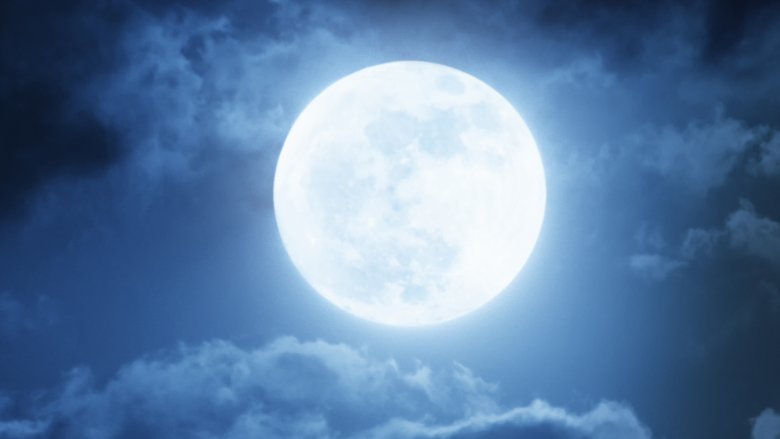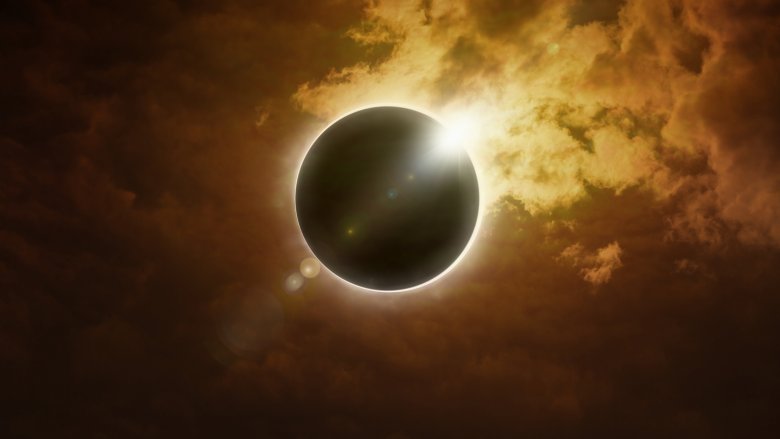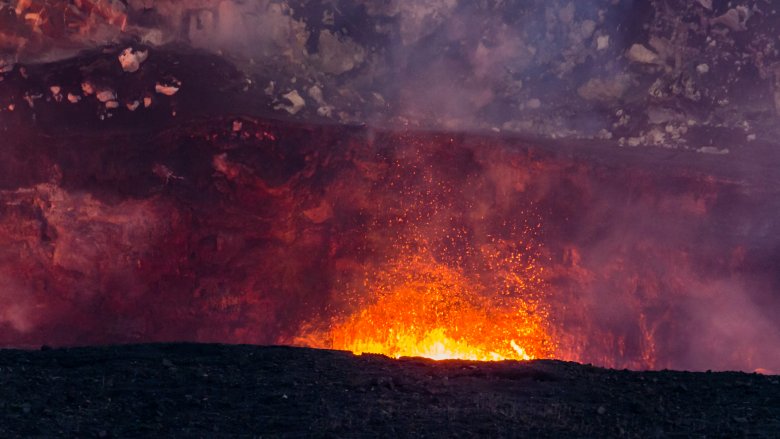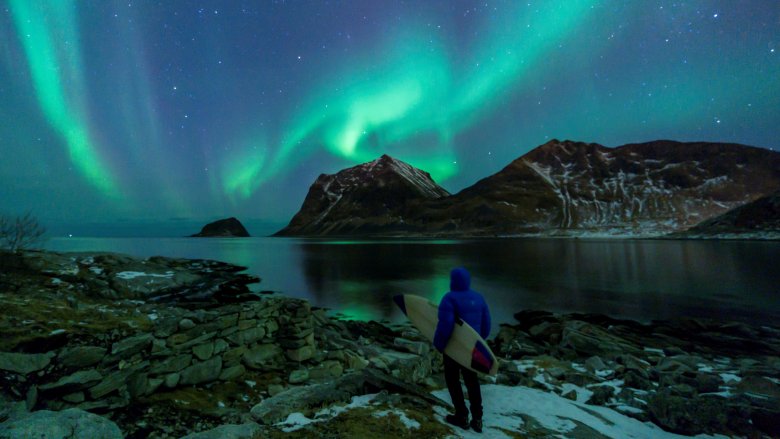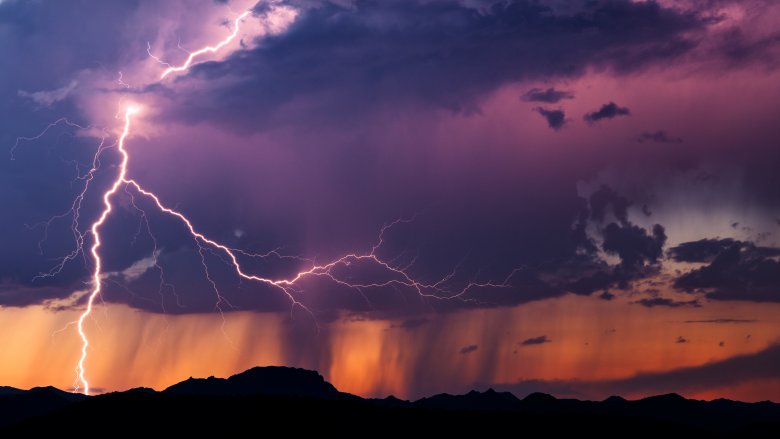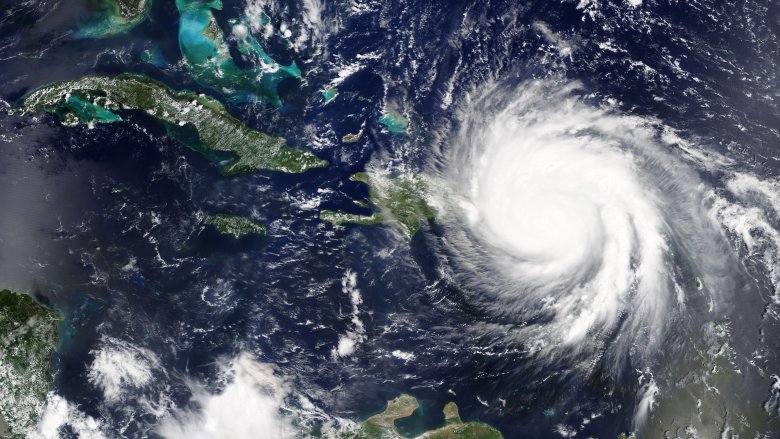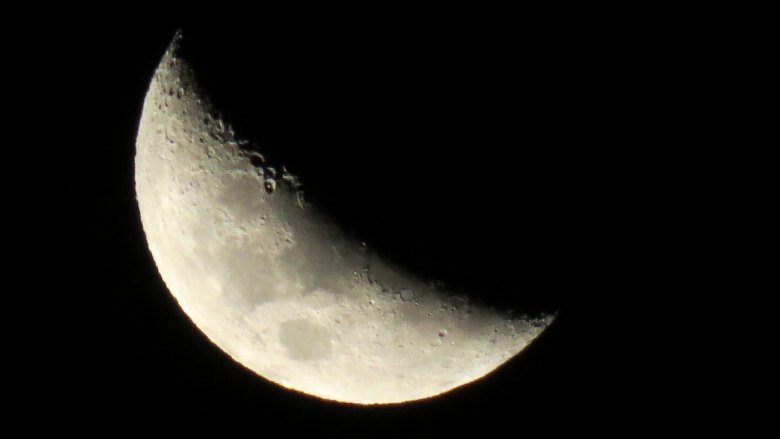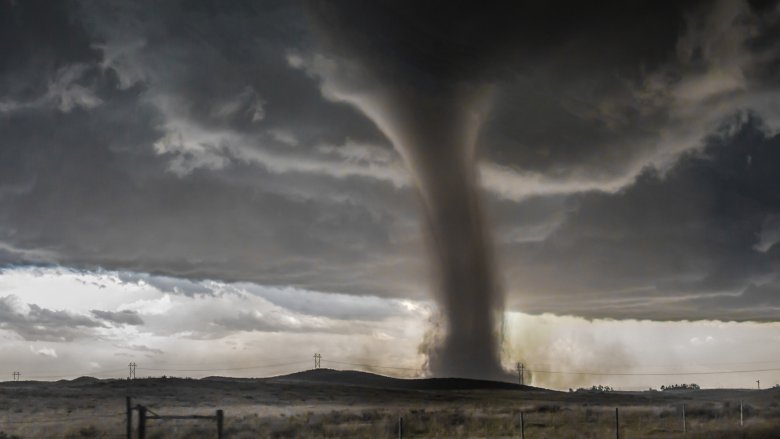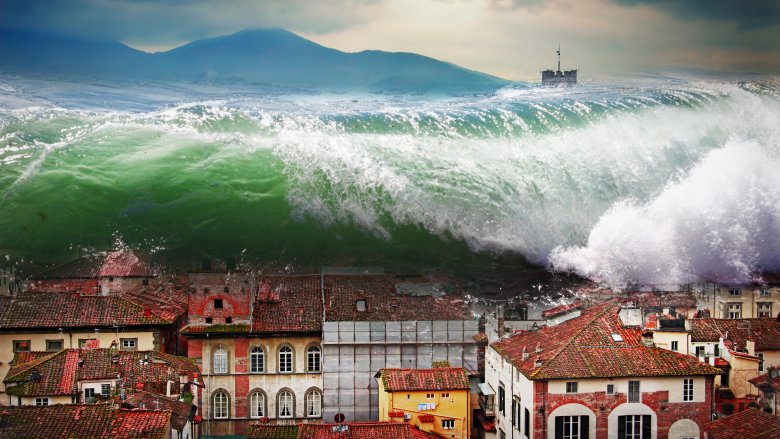Ancient Explanations For Natural Phenomena
When it comes to a basic understanding of things like weather and astronomy, human beings (with a few notable exceptions) are pretty enlightened. Sure, there are way too many people who like to pretend that the Earth isn't getting any hotter, but that's willful ignorance, not actual ignorance. When you start to hear people say the Earth isn't warming because there's an ancient supernatural ice creature living on the Moon that cools the Earth with its frosty breath and has been doing so since the beginning of time and therefore the climate will never change, well, that's when it's time to really start feeling afraid for the future of the human race.
Today we have irrefutable scientific explanations for natural phenomena like eclipses, comets, and hurricanes. And all that scientific evidence has settled the questions about just why the Earth sometimes shakes and what causes massive coastal storms. But ancient peoples didn't have data and white lab coats and other things that make science irrefutable, so they had to come up with their own explanations.
This giant ball of hot gas is super-tasty
Today a solar eclipse is cause for celebration, statewide traffic jams, counterfeit eclipse glasses, and people ruining their eyes because they weren't warned about the counterfeit eclipse glasses. In ancient times, a solar eclipse was often a portent of doom. According to Ancient Origins, the Greeks believed that bad things would follow a solar eclipse, and that was pretty tame compared to what some other cultures thought.
The idea that some terrifying creature was trying to devour the Sun is pretty widespread — the ancient Chinese thought it was a dragon, while the Vietnamese were pretty sure it was a giant frog. But the winner of the "which sun-eating creature is more scary" contest goes to Hindu mythology, which says that during an eclipse the Sun is swallowed accidentally by the decapitated head of a demon.
In other cultures, the Sun was merely thought to have been stolen, usually by misbehaving canines. The Koreans believed it was supernatural dogs, and the Vikings said it was wolves. The best of all the legends, though, probably comes from a tribe in West Africa — in their mythology an eclipse would occur when the Sun and Moon were having a disagreement, which humans alone could end if only they would all just get along. On the other hand, if that one were true we would all be in the shadow of a permanent solar eclipse.
Messages of doom
The thing about comets is that one will probably eventually kill us all, so in a way the ancient legends about them aren't really that far off. Ancient Origins says the Greeks and Romans both believed the appearance of a comet was a prophecy of some major event, whether good or bad. A comet that appeared shortly after the assassination of Julius Caesar was believed to have validated Caesar's claims of divinity, which must have kind of sucked for the senators who killed him.
Most of the time, though, comets were thought to portend doom — comets appeared before the death of Charlemagne in 814, before the conquest of England in 1066, and before the eruption of Vesuvius in 79 A.D.
Even in modern times there are people who think comets have some supernatural significance — in 1910 a pseudo-religious group called "The Sacred Followers" tried to sacrifice a virgin because they thought Halley's comet was coming to get them. And in 1997 there was more than one group that thought the comet Hale-Bopp had sinister, alien motivations.
All the doom and death attached to comets doesn't really factor in the part where there have been loads of historical tragedies, battles, and disasters that were not preceded by the appearance of a comet, but evidently that isn't really something that ancient people thought about.
God drama, smiting, etc.
The sucky thing about having multiple gods is it seems like they're always fighting with each other, but at least all that god drama and unconstrained smiting is a pretty great way to explain the unexplainable.
The native Hawaiians were surrounded by the unexplainable and unpredictable — they lived in one of the most volcanic places in the world, where massive eruptions were just another day in paradise. And according to the BBC, scientists can actually find evidence of ancient volcanic eruptions just by looking at the Hawaiian mythology. For example, Pele, the goddess of Kilauea, is said to have set fire to a forest as an act of revenge against her sister Hi'iaka. Pele threw the body of Hi'iaka's lover into the crater of Kilauea, and when Hi'iaka tried to dig to dig him out, she sent rocks flying into the air. Volcanologists believe the myth tells the tale of the 15th-century eruption of Kilauea, which lasted for 60 years and eventually caused the summit to collapse into a caldera.
Some people believe the story of Atlantis might be similarly based on an actual volcanic event, which could one day maybe lead to the discovery of the lost city. That would be cool, since over the years Atlantis has kind of ballooned into like the stupidest legend ever, and it really is time for it to end up being just a bunch of rubble at the bottom of an underwater volcano.
Ghosts that are 250 miles tall
The names "Aurora" and "borealis" came from the Greeks, who believed the northern lights were the goddess of dawn riding her chariot across the sky. Boreas, the north wind, was said to make the lights move. According to the Telegraph, the indigenous Sami people of Scandinavia and parts of Russia believed the lights came from the souls of the dead, which is terrifying because researchers say the aurora borealis are somewhere between 50 and 250 miles tall. Instead of rushing outdoors to admire them, which is what modern humans do, the Sami stayed indoors for fear the lights would take them.
A lot of myths about the northern lights have to do with lost souls — the people of Greenland thought the northern lights were the souls of stillborn babies. The North American Fox tribe thought the lights were the souls of their dead enemies, which is really pretty terrifying when you consider that a dead enemy could not possibly have a peaceful motivation for paying a visit. Some tribes in Canada believed their ancestors' souls were kicking around the skull of a dead walrus, which is not quite as sinister as it is weird.
A few outliers thought the northern lights might be something other than creepy souls being extra-creepy — the Scots preferred to think of the lights as dancers, which is very sweet and kind of surprising coming from a culture that also believed in a kind of Loch Ness pony.
The terrifying sound of ... goats
In Norse mythology, thunder happens when the god Thor battles Dark Elves for possession of the Reality Stone. Oh wait, that's Marvel mythology. In Norse mythology, Thor rides around the sky in a chariot pulled by two goats, which for a super sexy and all powerful god of thunder kind of sounds like a totally wimpy thing to do. Goats? Because stallions or fire breathing dragons are too manly for you, god of thunder?
Anyway, according to Norse Mythology, Thor rides around on his chariot with his two goats called "Teeth Barer" and "Teeth Grinder," which is ambitious but okay. So the goats pull the chariot, and when the wheels roll across the sky the people on Earth hear thunder, and when they make sparks the people see lightning. Thor can also create lightning with his hammer, which he does a lot because he's feeling emasculated about the whole goat-pulled chariot thing.
Unsurprisingly, lots of other cultures also had divine explanations for thunder and lightning — the Greeks thought lightning was a weapon of Zeus, and they often erected temples in the places where lightning struck, mostly so they could ask the gods to please stop hitting them with lightning.
Dragons and/or sore losers
It's hard to believe, but once, hurricanes were not just political tools and fun challenges for the graphics departments at major news outlets. Hurricanes actually destroyed homes, lives, and sometimes even killed people. Wait, you mean that still happens today? Jeez.
Anyway, back in the dark times, before massive animation budgets at major news outlets, when huge, terrifying storms descended without warning on coastal populations, it was easy to imagine that there must be a supernatural force behind all the destruction. According to Ancient Pages, the Chinese believed that hurricanes were caused by fierce dragon kings who lived beneath the sea in palaces made from crystal. Hurricanes happened when the dragon kings breached the surface of the water and flew through the air.
The Greeks had ideas about hurricanes, too, because the Greeks had ideas about everything. In Greece, massive coastal storms were called cyclones, and they were caused by the god Poseidon, who cursed the city of Athens after he lost a battle of wits against the goddess Athena. So, yay girl power, boo hurricane curses. Older Greek mythology has another hurricane myth — some stories say that Zeus had some buddies called the Hekatonkheires who had 50 heads and 100 hands, and they could use their ridiculous number of appendages to smack the water around and whip up a hurricane. Yikes.
A celestial kegger
Human beings have actually walked on the Moon, yet beliefs about our celestial neighbor's cosmic influence are remarkably persistent. Just ask any kindergarten teacher with a classroom full of riotous kids on a full moon. In fact the word "lunatic" comes from the Latin "luna" for moon because of the one-time widespread belief that the crazies come out during those few fully illuminated nights of the month. But most modern people over the age of, say, 8 understand the science behind the waxing and waning of the moon — in the old days, it wasn't so simple.
According to India Divine, in the historical Vedic religion (which formed part of the basis for modern Hinduism), the Moon was one of aspects of Soma, which you may remember from the flashback you just had to your middle school English class was also the name of the drug used to keep the population compliant in Aldous Huxley's Brave New World. In the Vedic mythology, Soma was the elixir of the gods. The Moon was sometimes seen as the cup where Tvastar, the guardian of Soma, kept the magical drink. The Moon waned when the gods were having their mystical version of a kegger, and it waxed when the cup was topped up.
Explanations for the waxing and waning of the Moon vary quite a bit, but interestingly, almost no ancient legend seems to include riotous kindergarteners. Maybe the problem is that teachers are tired and don't get paid enough.
A pachyderm with an itch
Earthquakes are another natural phenomenon that really begs for some sort of cosmic explanation. It's really easy to imagine how ancient people might have mistaken that seemingly random shaking of the earth as an angry god trying to rattle some sense into an unruly population.
According to Scientific American, the Japanese once believed that an eternal struggle between the god Kashima and a giant catfish called Namazu is the root source of an earthquake. Kashima is tasked with immobilizing Namazu with a large stone, but even gods get sick of repetitive tasks and every now and then Kashima slacks off. When that happens, the fish wiggles his enormous tail, and the world gets an earthquake.
The idea that earthquakes are caused by giant animals is actually a pretty common one. In some Native American traditions, the mythical thunderbird caused earthquakes and tidal waves whenever he had a disagreement with a whale. In China, the traditional explanation for an earthquake is the very precarious position of Planet Earth, which is wedged in between a bunch of elephants, which are standing on the back of a turtle, which is held up by cobra. So when one of the elephants has to scratch itself, or really move at all, the planet shakes.
Some weird horse thing with a snake's backside
Tornadoes are so terrifying that they've even spawned modern legends — there's that one about the girl who was swept up in a tornado and then ended up in a magical land populated by witches and flying monkeys, and there was also that one legend where Bill Paxton chases tornadoes around for fun and adventure, which no one remembers because that movie sucked.
Anyway, tornadoes are scary, and if you've ever witnessed the destruction one of them leaves behind, it's pretty wrath-of-god. So ancient people not only needed an explanation for tornadoes, they also needed some sort of hope that they could be controlled or at least diverted, because otherwise crap.
According to NPR, the Kiowa tribe of Oklahoma believed that tornadoes were caused by a mystical "Storm-Maker" named Red Horse. Red Horse was equine in almost every way except for his tail, which was the backside of a snake. When Red Horse whipped his tail, it made a tornado.
Thankfully, there were also people within the tribe who supposedly possessed the ability to divert a tornado, which was handy if you weren't crazy about the idea of packing up an entire village on short notice because Red Horse was planning a visit. The idea that humans can influence the direction of a tornado even persists in some communities today.
Shapeshifting ground shakers
Tornadoes are scary, and so are earthquakes and hurricanes and volcanoes, but if you want to talk uber, ultra scary, then a 1,720-foot tsunami is about as bad as it gets.
Like the native Hawaiians, the ancient people of the northwestern United States lived under the constant threat of natural disaster, only their supernaturals stirred up the waves instead of the mountains. And evidence of past events can be found in their verbal stories, too.
According to Forbes, Duwamish legends say there are boulders along the shores of Puget Sound that are haunted by terrifying shape-shifters. Anyone hoping to approach the boulders knows not to do it from the coastal side, because the angry spirits will shake the ground and whip up enormous waves to punish the hapless trespasser. Researchers have been able to identify the source of some of these boulders — a prehistoric landslide that may have been associated with a major earthquake and tsunami event. It makes sense that these sites ended up with terrifying legends attached to them. First, the legends warned people about tsunamis, and second, mobile boulders do sort of cry out for a supernatural explanation.
These stories are echoed in other tsunami-prone areas, too, but the major common denominator is the question of what one should do in case of a tsunami. "When the sea disappears," warn old stories from Thailand, "don't look back, but run as fast as you can to the next hill."
